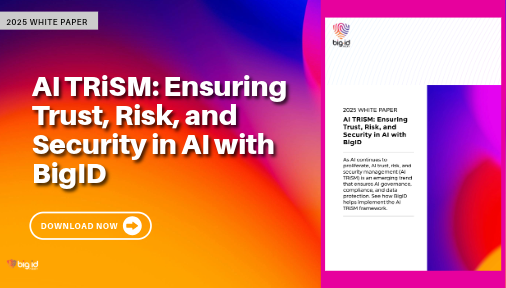Whether it was kings sending messages in code or cybersecurity professionals dealing with malware, we’ve always fought hard to protect our data. DSPM for AI is just the latest tactic in this everlasting battle.
And it’s much needed.
Data Security Posture Management for AI: Strengthening Data Protection and Compliance
Artificial intelligence is changing the way we work. It has simplified processes through smart automation. It has provided everyone with a supportive assistant with whom to talk things through. Yes, adopting AI has definitely made a positive impact on how businesses carry out their processes.
At the same time, it has also created new gaps in data security.
The problem is, you can’t rely on data loss prevention (DLP) solutions that are designed to stop external attacks. In the case of AI, several of the threats actually come from within.
What do we mean? Employees might unintentionally input sensitive data into AI models to make their work easier. Or developers might accidentally use real customer data in training sets. Training data might be drawn from databases that weren’t properly vetted and had sensitive data mixed in with publicly available data.
These risks don’t come from outside. It’s your own processes that create these vulnerabilities.
Plus, AI has introduced other new types of risks. AI models process and consume data differently from other applications. For example, a piece of software might use information in a defined algorithm that generates specific results, while AI models learn patterns to make predictions. They can use sensitive information in ways you neither intended nor expected.
That’s why data security posture management (DSPM) is so important. It doesn’t just build a perimeter to protect against external threats. Instead, it maps and classifies your data. Once it determines the sensitivity of your data points, it helps you implement appropriate policies to govern its flow and use.
In short, DSPM for AI gives you more visibility and control over how your data is used in these systems. That, in turn, keeps you compliant and the model trustworthy.
New Data Security Risks Within AI Agents and Models
Unpredictable Data Flows
When you train or use an AI model, sensitive data doesn’t just sit in one place. It’s collected, duplicated, transformed, and sometimes even exposed to third-party services. Information that was once locked in a secure database could now end up in training datasets.
If you delete a bit of information from an Excel sheet, it’ll no longer be used in calculations. However, an AI model’s memory is quite like our own. You can’t just forget information that is central to your thought process, and neither can the model.
As a result, you can’t be sure if and when this data might appear in its outputs. Even anonymized data can sometimes be re-identified through inference or correlation.
Data Quality and Integrity
AI models depend on high-quality, accurate data. The problem is, most organizations don’t have a single, clean source of truth. If your datasets are outdated, duplicated, or inconsistent, you’ll get inaccurate or biased results. This goes against the emerging AI regulation laws, like the EU AI Act or NIST’s AI risk management framework (RMF).
In regulated industries, data quality issues can also turn into compliance risks. Without visibility and governance, poor data quality compromises your AI’s output. Neither your organization nor your users can trust it.
Shadow AI
“Shadow IT” is the unsanctioned apps used by employees. “Shadow data” is hidden data that you’re not aware you own. And, “shadow AI” refers to AI apps your team members use without proper oversight. Someone using a generative AI chatbot like ChatGPT to summarize a report is doing it for convenience, but it’s also risky. They are potentially uploading sensitive data to a third party tool.
Because it’s all unsupervised, you won’t even be aware that it’s happened and therefore, can’t create safe use policies around it.
Toxic Risk Combinations
Some risks aren’t evident until the systems, users, and datasets interact. You might think you’ve stripped the information of personal identifiers adequately. Or, there might not be any sensitive data obviously included. However, when combined with other sources or processes, it becomes problematic.
- Shadow AI being given sensitive business data is one such instance. The users treat the tool as their personal assistant, but it is an external party. You think the information is limited to your employees, but there’s a gap in the process where it’s being exposed.
- Improperly configured data access gives users more privileges than they need for their jobs.
- Or, you might think you’ve masked or sanitized your information (such as through anonymization). However, it can be revealed when combined or cross-referenced with another dataset.
For example, let’s take Netflix’s 2006 data release. The company had a research competition for which it published what it believed was anonymized viewing data. However, researchers later showed that by cross-referencing the dataset with IMDb profiles, they could re-identify specific users and infer their viewing habits.
The same principle applies to AI, which can be extremely effective at inferring with very little context. AI interaction with different datasets and permissions can potentially reveal sensitive information or enable unintended inferences. These “toxic risk combinations” are hard to spot manually and definitely not through traditional security controls.
Expanding Attack Surfaces
Every API connection, training dataset, and AI integration adds another point of exposure that threat actors can target. And target them they do, using techniques ranging from model poisoning to prompt injection.
These changes mean that security teams can’t just focus on defending the perimeter anymore. Data needs protection at every stage — where it’s collected, how it’s processed, and where it ends up.
DSPM gives you the visibility and context to understand how sensitive data flows through AI applications. It provides the tools to secure it without slowing down innovation. Plus, it detects any applications, including ones that weren’t sanctioned by your organization, that are using your data.
In short, DSPM helps you see, understand, and secure your data — whether it’s flowing through your AI apps or hiding in places you didn’t even know existed.
How DSPM Protects Data in the Age of AI
When people say we live in a world of information technology, both components of the term are equally important. Technology is key, but so is information. In fact, we are inundated with it.
As a business, you collect customer data, employee details, and organizational information. No matter how neatly you arrange it all, it almost always evolves into a writhing mass of entangled flows and stores.
A department collects information into a database, and another makes a copy of it for its own use. Now you have two copies of the same information.
A system overhaul means you stop using a source of information, but forget to delete it. Old data is not updated, but you use up terabytes of space storing it.
That’s not even touching on how this data flows through your systems and applications. That’s exactly how it ends up “in the shadows.” This isn’t just bad for governance; it also means any AI model you train will be fed poor-quality data.
DSPM helps you bring order to this chaos. Here’s how it works:
Data Discovery and Classification
AI models rely on massive amounts of data, and not all of it is equal. Publicly available information doesn’t need much protection. On the other hand, sensitive consumer information is regulated. You need to collect, process, and share it according to guidelines. If you don’t, you risk regulatory repercussions.
DSPM automatically scans your data sources, whether in cloud storage or training repositories. It classifies data by type and sensitivity, so you can instantly see what needs stronger protection.
Visibility Into Data Flows
Once your data is mapped, DSPM gives you a clear view of where it’s going and how it’s being used.
Is data being shared with a third-party model, moved to a new environment, or used in training? DSPM tracks its journey to provide transparency that helps you ensure data stays where it’s supposed to. That way, it doesn’t end up in unauthorized or high-risk systems.
Access Control and Least Privilege
DSPM assesses who can view and use sensitive training and production data. If there are unnecessary privileges and overexposed datasets that could lead to leaks, it will flag them. Integrate it with identity and access management (IAM) systems, and it enforces least-privilege policies to reduce insider risk.
Continuous Monitoring and Risk Detection
AI systems change constantly. Models are updated, new datasets are added, and integrations evolve. DSPM continuously monitors for all of these.
It will map and classify new or altered data automatically. Configuration issues that can be exploited are flagged before they become an issue. Risky sharing behaviors are brought to your attention so you can address them.
When a policy is violated, your AI DPSM solution automatically alerts your security team or triggers a remediation workflow.
Compliance and Governance Alignment
AI often intersects with privacy laws like GDPR, CCPA, or HIPAA, especially when personal data is used in training. DSPM automatically links data back to its source to document lineage and generate audit-ready reports. It simplifies compliance and helps you prove that sensitive data is managed responsibly and used within legal bounds.
Using Data Security Posture Management Effectively
Implementing DSPM for AI isn’t just deploying another security tool. It’s laying the right foundations so your data, models, and systems all operate within a clear, compliant framework. To use data security posture management effectively, you need to establish strong governance and integration practices from the start.
Prerequisites for Implementing DSPM in AI Systems
Before deploying DSPM for AI, organizations should lay the groundwork to ensure a smooth rollout and maximum impact.
Establish Governance and Compliance Policies: Define how sensitive data should be handled, stored, and shared in accordance with frameworks like GDPR, CCPA, and HIPAA.
Prepare System Integrations: Ensure your IAM, DLP, and monitoring tools can connect with DSPM for unified visibility and policy enforcement.
Identify Key AI Data Sources: Know where your AI data lives — such as training repositories, model storage, and pipelines — so DSPM can begin automated discovery efficiently.
Align Teams and Roles: Involve data owners, AI engineers, and compliance leaders early to define responsibilities and ensure adoption across departments.
Once these prerequisites are met, AI DSPM takes over. It automatically maps data, classifies sensitive information, and monitors usage to maintain a strong, compliant data security posture.
Why BigID Leads in DSPM for AI
BigID gives the visibility, intelligence, and automation that your modern AI environments demand. The AI-ready DSPM platform goes beyond discovery; it understands context, sensitivity, and relationships between data, users, and models.
With BigID, you can:
- Discover and Classify AI Data Automatically: Identify sensitive, regulated, and high-risk data across training sets, pipelines, and model repositories.
- Detect Toxic Risk Combinations: Pinpoint where AI interactions, overlapping datasets, access privileges, or model inputs could lead to data exposure or re-identification.
- Enforce Policies with One Click: Automate remediation, masking, or access revocation directly from data classification results to reduce manual work and misconfigurations.
- Monitor AI Data Continuously: Track how data flows into and out of AI systems to ensure compliance and prevent shadow AI usage.
- Align AI Data Governance with Compliance: Map data lineage for audit readiness under GDPR, CCPA, HIPAA, and emerging AI-specific regulations.
- Accelerate Responsible AI: Ensure the data feeding your models is accurate, secure, and ethically governed, and improve both compliance and model trustworthiness.
BigID gives you the tools to see, understand, and control your AI data — so you can innovate confidently without compromising on privacy or compliance. Interested in learning more about how BigID can help you? Schedule a demo today!


